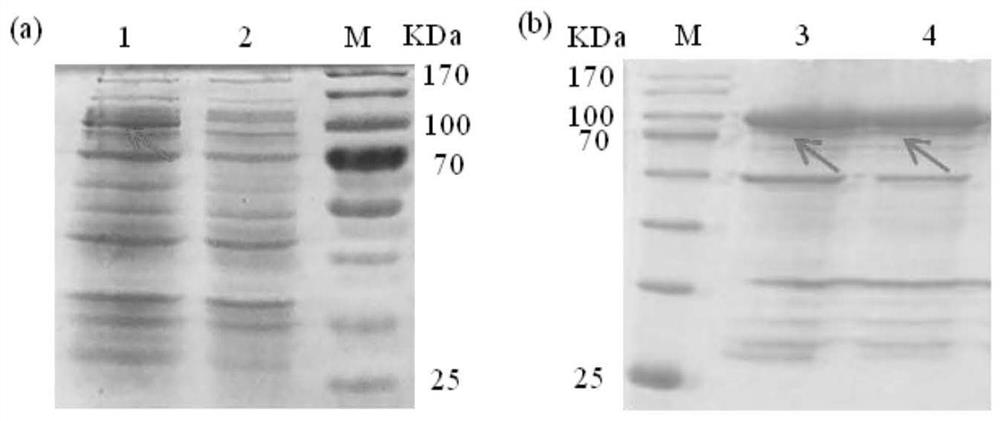Brassica napus bntlk1 gene related to fungal diseases and its application
A technology for cabbage rape and fungal diseases, which is applied in the directions of application, genetic engineering, plant genetic improvement, etc., can solve the problems of unclear biological functions, loss of rape yield and quality, etc., and achieve the effect of improving sclerotinia resistance.
- Summary
- Abstract
- Description
- Claims
- Application Information
AI Technical Summary
Problems solved by technology
Method used
Image
Examples
Embodiment 1
[0035] Example 1: BnTLK1, BnTLP TLK1 Gene cloning and sequencing
[0036] Take the young leaves of Shuang11 in rapeseed, use TriZol Reagent (life technologies company) to extract total RNA of rapeseed, use NANODROP software to detect the content and purity of total RNA, take 2.0 μg of total RNA for reverse transcription, the reverse transcription method used The kit is a product of Takara Company, and the reverse transcription reaction steps refer to the instructions of the kit. Using the cDNA synthesized by reverse transcription reaction as a template, use primers:
[0037] BnTLK1: 5'-ATGTTCGCAGGAGTGTTGTC-3'
[0038] 5'-TAGTGGCTTGGTGTCAAAA-3'
[0039] BnTLP TLK1 : 5'-ATGTTCGCAGGAGTGTTGTC-3'
[0040] 5'-TAATTGGGAATGGACGAGG-3'
[0041] Carry out conventional PCR amplification; PCR reaction system (50 μL) is: 2 μL cDNA, forward / reverse primer (concentration 10 μM) 2 μL each, 2×Phanta Max Master Mix is 25 μL and 19 μL ddH 2 O. Mix well after adding the sample on ice. T...
Embodiment 2
[0042] Example 2: Cloning and sequence determination of AtTLK1 specific sequence
[0043] Take the young leaves of wild-type Arabidopsis thaliana, use TriZol Reagent (life technologies company) to extract total RNA, use NANODROP software to detect the content and purity of total RNA, take 2.0 μg of total RNA for reverse transcription, the reverse transcription method used The kit is a product of Takara Company, and the reverse transcription reaction steps refer to the instructions of the kit. Using the cDNA synthesized by reverse transcription reaction as a template, use primers:
[0044] 5'-ATCTCGGCTAGGACGCTATG-3'
[0045] 5'-TTCAACAACGCAACCAGCGC-3'
[0046] Carry out conventional PCR amplification; PCR reaction system (50 μL) is: 2 μL cDNA, forward / reverse primer (concentration 10 μM) 2 μL each, 2×Phanta Max Master Mix is 25 μL and 19 μL ddH 2 O. Mix well after adding the sample on ice. The PCR reaction conditions were: 95°C for 3min; 95°C for 15sec, 53°C for 15sec, 7...
Embodiment 3
[0047] Example 3: Prokaryotic expression and purification of BnTLK1 protein
[0048] The expression vector used in the present invention is pGEX-4T-1, with GST tag, and the schematic diagram of GST-BnTLK1 prokaryotic expression vector is as follows figure 1 As shown, the BnTLK1 gene (SEQ ID NO.1) was obtained by PCR reaction cloning, using primers:
[0049] 5'-ATCTGGTTCCGCGTGGATCCATGTTCGCAGGAGTGTTGTC-3'
[0050] 5'-GCTCGAGTCGACCCGGGAATTCCTAGTGGCTTGGTGTCAAAA-3'
[0051] Perform PCR amplification, and the amplification template is the pEASY-BnTLK1 recombinant plasmid in Example 1. PCR reaction system (50 μL): 2 μL cDNA, forward / reverse primer (concentration 10 μM) 2 μL each, 2×Phanta Max Master Mix 25 μL and 19 μL ddH 2 O. Mix well after adding the sample on ice. The PCR reaction conditions are: 95°C for 3min; 95°C for 15sec, 53°C for 15sec, 72°C for 90sec, 32 cycles; 72°C for 10min. After the target fragment was recovered by agarose gel electrophoresis, the pGEX-4T-1 vect...
PUM
| Property | Measurement | Unit |
|---|---|---|
| concentration | aaaaa | aaaaa |
Abstract
Description
Claims
Application Information
 Login to View More
Login to View More - R&D
- Intellectual Property
- Life Sciences
- Materials
- Tech Scout
- Unparalleled Data Quality
- Higher Quality Content
- 60% Fewer Hallucinations
Browse by: Latest US Patents, China's latest patents, Technical Efficacy Thesaurus, Application Domain, Technology Topic, Popular Technical Reports.
© 2025 PatSnap. All rights reserved.Legal|Privacy policy|Modern Slavery Act Transparency Statement|Sitemap|About US| Contact US: help@patsnap.com



